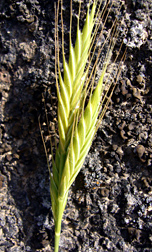Washington, DC
November 13, 2008
Agricultural Research Service, USDA
By Don
Comis
 |
|
Brachypodium distachyon. Photo courtesy of Zoya
Akulova-Barlow. |
An
Agricultural Research Service
(ARS) scientist has developed a special population of plants of
the wild grass Brachypodium distachyon (Brachypodium)
that will help speed up scientists' search for genes that could
help wheat and other major crops resist diseases such as Ug99, a
form of stem rust that threatens 80 percent of the world's
wheat.
The plants developed by ARS
plant geneticist
David Garvin are the first recombinant inbred line (RILs)
population of Brachypodium. This means offspring of each
line in the population will retain the same genetic identity in
perpetuity, according to Garvin, who works at the ARS
Plant Science Research Unit in St. Paul, Minn. This allows
scientists to more efficiently explore the genetic and molecular
basis of a range of traits.
Previously, Garvin had
developed earlier versions of populations segregating for genes
and traits, but those populations permitted only one look at the
genetics of a given trait. With the new RILs, all the offspring
of each line will always have the same genes, so scientists
around the world can repeat experiments as often as they desire.
The ability to work with large
numbers of plants with the same genetic makeup gives scientists
the opportunity to obtain highly accurate information on the
number of genes that control a trait. This provides a strong
start toward identifying the location of these genes on
Brachypodium chromosomes.
It took Garvin more than three
years to create the RILs. The research involved crosses and
growing the entire population to maturity repeatedly to fix the
genetic make-up of each plant. He has many additional RIL
populations nearing completion.
ARS is a scientific research
agency within the U.S. Department
of Agriculture.
Un científico del
Servicio de Investigación Agrícola (ARS) ha desarrollado una
población especial de plantas del pasto silvestre
Brachypodium distachyon. Esta población ayudará a acelerar
la búsqueda científica para los genes que podrían ayudar al
trigo y otros cultivos principales a resistir enfermedades tales
como Ug99, la cual es una forma de la roya del tallo que amenaza
el 80 por ciento del trigo mundialmente.
Las plantas desarrolladas por
genetista de plantas
David Garvin componen la primera población de una línea
endogámica recombinante (RILs por sus siglas en inglés) de
Brachypodium. Esto significa que los descendientes de cada
línea en la población retendrán la misma identidad genética a
perpetuidad, según Garvin, quien trabaja en la
Unidad de Investigación de la Ciencia de Plantas mantenida
por el ARS en Saint Paul, Minnesota. Esta característica permite
que los científicos puedan explorar más eficazmente las bases
genéticas y moleculares de una gama amplia de rasgos.
Anteriormente, Garvin
desarrolló otras poblaciones de las plantas segregándolas
basadas en sus genes y rasgos específicos, pero esas poblaciones
permitieron solamente una mirada de la base genética de un rasgo
específico. Con las RILs, todos los descendientes de cada línea
siempre tendrán los mismos genes, para que científicos
mundialmente puedan repetir experimentos tan frecuentemente como
quieran.
La capacidad de trabajar con
números grandes de plantas que tienen la misma composición
genética ofrece a los científicos la oportunidad de obtener
información altamente precisa sobre el número de genes que
controlan un rasgo específico. Este es un paso importante hacia
identificar la localización de estos genes en los cromosomas de
Brachypodium.
Garvin trabajó por más de tres
años para crear las RILs. Su investigación involucró realizar
muchos cruces de plantas y crecer la población entera a la
madurez muchas veces para fijar la composición genética de cada
planta. Él tiene muchas otras poblaciones de RILs que están casi
terminadas.
ARS es una agencia de
investigaciones científicas del
Departamento de
Agricultura de EE.UU. |